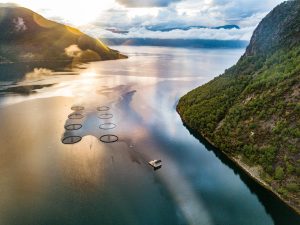Eco-labeling in aquaculture: Ensuring sustainable products

Dive into the fascinating world of eco-labeling and discover how this practice is transforming purchasing decisions in the aquaculture industry. As environmental awareness grows, consumers increasingly seek marine products from sustainable sources. In this article, we explore standards, certifications, and the impact of eco-labeling on the sustainability of seafood.
Eco-labeling: A deep dive
Eco-labeling in aquaculture is a key tool to inform consumers about the sustainability of the products they choose. This practice involves placing labels or seals on seafood products, indicating compliance with certain environmental and social standards. By adopting these labels, producers and distributors commit to practices that reduce negative impacts on aquatic ecosystems and promote social responsibility.
Rigorous standards for sustainability
Various organizations, such as the Marine Stewardship Council (MSC) and the Aquaculture Stewardship Council (ASC), have established rigorous standards to assess and certify sustainability in aquaculture.
MSC:
- Sustainable Management: Companies must demonstrate that their fishing practices do not threaten fish populations’ health or harm the marine ecosystem.
- Reduced Environmental Impact: Evaluation includes minimizing bycatch and reducing pollution.
- Good Management: Fisheries management must be effective, ensuring the long-term preservation of fish populations.
ASC:
- Animal Welfare: Aquaculture practices must ensure the welfare of farmed fish and other cultivated organisms.
- Environmental Management: Evaluation includes minimizing pollution, conserving biodiversity, and sustainably using natural resources.
- Social Responsibility: Recognition is given to respecting the rights of workers and local communities.
Globally recognized certifications
Certifications associated with eco-labeling are recognized worldwide and play a crucial role in creating a sustainable supply chain. Obtaining certifications such as MSC for wild-caught fish or ASC for aquaculture means operations comply with specific sustainability criteria.
These certifications not only ensure environmentally responsible practices but also promote transparency in the supply chain. Consumers, by identifying these seals on products, can trust that they are contributing to ocean preservation and supporting companies committed to ethical and sustainable standards.
Impact on consumer decision-making
Eco-labeling benefits not only marine ecosystems but also empowers consumers by providing transparent information about the origin of seafood products. Sustainability-conscious consumers can make informed purchasing decisions, supporting companies committed to responsible practices. This shift in market demand compels more producers to adopt sustainable practices to maintain relevance in an industry increasingly focused on environmental responsibility.
Challenges and opportunities in eco-labeling
Although eco-labeling has made significant strides, it faces challenges from supply chain verification to standard variability in different regions.
- Supply Chain Verification: Ensuring the authenticity of information from origin to the final consumer poses a challenge, as some operations may struggle to meet standards at every stage of the chain.
- Standard Variability: Lack of global standardization can lead to different interpretations of what it means to be sustainable, generating confusion among consumers and challenges for producers operating in multiple markets.
Opportunities for improvement and standardization
Despite these challenges, there are significant opportunities to improve and standardize sustainability practices globally. Collaboration between governments, NGOs, and the industry can contribute to the creation of more uniform standards and more effective monitoring systems.
- Global Collaboration: Establishing international alliances to harmonize standards and certification procedures can reduce variability and enhance consumer confidence in eco-labeling.
- Technological Innovation: The application of technologies like blockchain can enhance traceability in the supply chain, ensuring that information provided to consumers is accurate and verifiable.
How to differentiate between high and low-demand eco-labels
When consumers encounter a variety of eco-labels, it is crucial to consider certain elements to assess the quality and stringency of each:
- Information Transparency: Stronger labels provide specific details about sustainable practices in production, from resource management to minimizing environmental impacts.
- Certification Recognition: Labels associated with recognized certifications, such as MSC and ASC, are reliable indicators of high sustainability standards.
- Inclusion of Social Factors: Labels that consider social aspects, such as labor and community responsibility, demonstrate a holistic approach to sustainability.
- Supply Chain Traceability: Labels using technologies like blockchain to track the product’s journey from farm or fishing to the end consumer provide greater authenticity assurance and compliance with standards.
By paying attention to these elements, consumers can make more informed decisions and support brands striving to meet the highest sustainability standards in aquaculture.
Closing the sustainability loop in aquaculture
In a world where individual choices can have a significant impact, eco-labeling emerges as a beacon of hope for sustainable aquaculture. Global collaboration and technological innovation are paving the way for more comprehensive and transparent standardization. As consumers become more aware, their power to drive sustainable practices through informed purchasing decisions becomes a vital engine for positive change.
Each eco-sustainable label is more than a badge on a product; it is a commitment to the health of our oceans, the preservation of marine life, and the prosperity of communities. Ultimately, eco-labeling not only reflects the current state of aquaculture but also the shared vision of a future where seafood production not only feeds populations but does so ethically and sustainably. With each informed choice, consumers become custodians of our oceans, propelling positive transformation in the aquaculture industry and leaving a lasting legacy for generations to come.
This article is presented by Aquanetwork, your reliable source for job opportunities in the aquaculture industry. Connect with employers and passionate professionals at Aquanetwork.


